
Former president Donald Trump is rushed offstage after being grazed by a bullet during a rally on July 13, 2024, in Butler, Pennsylvania. (Anna Moneymaker / Getty Images)
07.14.2024
Donald Trump was a reality TV host before he was president, and whatever else he is, he’s a consummate showman. On Saturday, he was shot at a rally. The bullet grazed his ear. A few inches off, and he would be dead. Showing a presence of mind, as he was getting whisked from the stage, he mouthed the word “fight” three times to the crowd while pumping his fist. The audience responded with chants of “USA! USA!”
The pictures of Trump pumping his fist as blood ran down his face became instantly iconic. While only time will tell, many despondent progressives concluded that the election was essentially over.
The attempted assassination of a former president — and the leading candidate in this year’s election — was a shocking act of political violence. Conspiracy theories quickly proliferated in some corners of the internet, since this is America in 2024 and online conspiracy theories rapidly proliferate about any shocking high-profile political event. At one point. “Staged” was trending on Twitter.
The assassination attempt was instantly and correctly condemned by figures like Bernie Sanders and Alexandria Ocasio-Cortez, just as it was by leading voices across the rest of the political spectrum. I have seen lots of people point out that, for example, more sympathy has been expressed for Donald Trump — a grotesque figure on any reasonable accounting — than for the tens of thousands of Palestinian civilians murdered in Gaza in the last nine months, and this is true, but it shouldn’t stop us from recognizing that these figures were correct to condemn the attempted assassination. Focusing on our ideological enemies’ hypocrisy is often tempting precisely because it lets us off the hook from having to figure out our own principles and values. And I’d argue that, in this case, those principles should be relatively clear.
You don’t have to be an absolute pacifist, or anything like one, to understand that normalizing this kind of violence would be a disastrous direction for our society to go down. Violence in general should require a high threshold of moral justification, and nothing remotely good would come from this kind of assassination — which would, if anything, further radicalize Trump’s supporters and be used to justify waves of extreme political repression.
Stochastic Terrorism?
Senator J. D. Vance (R-OH) immediately responded to the assassination attempt by blaming the White House — tweeting that the attempt was not just an “isolated incident” but a reflection of the Biden campaign’s core themes about Trump’s threat to democracy. In effect, conservatives like Vance are appropriating the idea, long put forward by some liberals, that overheated political rhetoric is itself a form of violence. The theory of “stochastic terrorism” holds that over-the-top rhetoric about a targeted individual or group has the effect of encouraging “lone-wolf” political violence — that is to say, political violence carried out by individuals on their own initiative rather than terrorist organizations — and that this makes the purveyors of the rhetoric responsible for the violence.
I’ve never seen anyone consistently apply this theory. Invariably, overheated rhetoric that you find unfair or irresponsible is blamed for violence against the targets of that rhetoric. Equally white-hot rhetoric you agree with, or which is put forward by factions to which you’re basically sympathetic, is given a more nuanced treatment, and (appropriate) skepticism is applied to the chain of causation.
If you’re an antiabortionist who calls abortion murder, you might still think this doesn’t justify the murderers of abortion doctors taking the law into their own hands. If you’re a left-liberal who believes Trump is literally a fascist, you might point out that it hardly follows from this that shooting him would diminish the fascist threat. In all cases, I’d argue that the “stochastic terrorism” theory dangerously undermines free-speech norms by blurring the line between speech and violence. Let’s not go down that road.
341 Million People and 393 Million Guns
In any case, the attempted assassin — Thomas Matthew Crooks — was likely not motivated by progressive outrage against Trump. We’re still very much in a “fog of war” situation where many facts remain to be sorted out, but current reports show that he seems to be a registered Republican. Someone with the same name and zip code donated to a Democratic PAC a few years ago. People who engage in lone-wolf political violence often seem to be mentally unstable individuals with ideologically incoherent mishmashes of political views. Even when a killer leaves a manifesto, sorting through their ravings to find evidence of ideological influences often renders confusing results.
Trump himself, of course, is a bubbling fountain of overheated political rhetoric who tried to overturn a democratic election and often spreads incendiary and dehumanizing rhetoric about liberals, the media, undocumented immigrants, and so on. The attempted assassination should not be excused, but it’s unsurprising that a figure like that would inspire extreme reactions, and unsurprising that some unstable people might be inspired to do something dangerous and stupid.
If we’re serious about diminishing the incidence of lone-wolf political violence in the United States, lecturing people to tone down the way they talk about figures like Donald Trump is unlikely to be an effective strategy. A more fruitful area to focus on is America’s gun laws, which are bizarrely permissive by the standards of other advanced democracies. Three hundred and forty-one million and change people live in this country, and we have about three-hundred and ninety-three million guns. If you want fewer political shootings, and fewer shootings in general, it’s long past time to do something about that.
CONTRIBUTOR
Ben Burgis is a Jacobin columnist, an adjunct philosophy professor at Rutgers University, and the host of the YouTube show and podcast Give Them An Argument. He’s the author of several books, most recently Christopher Hitchens: What He Got Right, How He Went Wrong, and Why He Still Matters.
The Trump rally shooting reveals a bipartisan consensus about what constitutes political violence — and who should wield it.

Campaign Against Militarism protest, 1994 | Image: Murray McDonald
A bipartisan sampling of the world’s greatest perpetrators and enablers of political violence has rushed to condemn political violence following the shooting attempt on former President Donald Trump on Saturday.
Politicians swiftly coalesced around the language of “political violence,” rather than terrorism, to describe the assassination attempt, carried out by Thomas Matthew Crooks, who was shot dead at the Western Pennsylvania rally. Taken together, the outpourings of condemnations betray a clear agreement on what constitutes political violence, and in whose hands the monopoly on violence should remain.
“The idea that there’s political violence … in America like this, is just unheard of, it’s just not appropriate,” said President Joe Biden, the backer of Israel’s genocidal war against Palestine, with a death toll that researchers believe could reach 186,000 Palestinians. Biden’s narrower point was correct, though: Deadly attacks on the American ruling class are vanishingly rare these days. Political violence that is not “like this” — the political violence of organized abandonment, poverty, militarized borders, police brutality, incarceration, and deportation — is commonplace.
“Everybody must condemn it,” Biden said of the assassination attempt.
And condemn it, most everyone in the Democratic political establishment has: “Political violence is absolutely unacceptable,” wrote Sen. Bernie Sanders, I-Vt., on X. “There is absolutely no place for political violence in our democracy,” tweeted former President Barack Obama, who oversaw war efforts and military strikes against Afghanistan, Iraq, Syria, Libya, Yemen, Somalia, and Pakistan with massive civilian death tolls; Obama added that we should “use this moment to recommit ourselves to civility and respect in our politics.” “There is no place for political violence, including the horrific incident we just witnessed in Pennsylvania,” wrote Rep. Alexandria Ocasio-Cortez, D-N.Y.
The chorus of condemnation was predictable and not in itself a problem: There’s nothing wrong with desiring a world without stochastic assassination attempts, even against political opponents. But when you have Israel’s minister of foreign affairs, Israel Katz of the fascistic ruling Likud Party, tweeting, “Violence can never ever be part of politics,” the very concept of “political violence” is evacuated of meaning.
The problem is not so much one of hypocrisy or insincerity — vices so common in politics that they hardly merit mention. The issue, rather, is what picture of “political violence” this messaging serves: To say that “political violence” has “no place” in a society organized by political violence at home and abroad is to acquiesce to the normalization of that violence, so long as it is state and capitalist monopolized.
As author Ben Ehrenreich noted on X, “There is no place for political violence against rich, white men. It is antithetical to everything America stands for.”
Trump and his Republican Party will no doubt remain committed to a political imaginary of apocalyptic race war and paranoid tribalism, which the assassination attempt will likely only feed. Democrats are welcome to perform civility toward the man who has consistently called for their violent overthrow, but they cannot help themselves to the pretense that their well wishes to Trump actually constitute calls for an end to political violence.
Democratic leaders will call for civility and continue to fill the coffers of police departments nationwide, while sending billions of condition-free dollars and bombs to Israel. Within the U.S., these condemnations of political violence now set the scene for even greater violent repression and policing of protest movements and dissent.
“We will not tolerate this attack from the left,” said Rep. Mike Kelly, R-Pa., who was present at the rally. Little is known about the suspected gunman’s ideology; he was reportedly a registered Republican who once donated to a Democratic PAC on Biden’s inauguration day.
Other Republicans meanwhile blamed Democrats for simply telling the truth about Trump’s far-right extremism. “Today is not just some isolated incident,” Ohio Sen. J.D. Vance wrote on X. “The central premise of the Biden campaign is that President Donald Trump is an authoritarian fascist who must be stopped at all costs. That rhetoric led directly to President Trump’s attempted assassination.”
If centrist Democrats stating the obvious about Trump can be slammed by Republicans as irresponsible, it bodes ill for any actual leftists organizing against fascist forces going forward — especially at a time when left-wing and pro-Palestinian protest movements are readily criminalized by both Democratic and Republican leaders. This is what peace means in a world where the only event to invoke a bipartisan chorus decrying “violence” is an attack on a fascistic former (and potentially future) world leader.
The shots fired at Donald Trump at a rally in Pennsylvania on Saturday are being investigated as an assassination attempt of the former president and current Republican presidential nominee.
Assassination attempts on presidents and presidential nominees are littered throughout American history. What happened in Pennsylvania is horrifying, but sadly not surprising.
I’ve been really struck by how many senior political figures in the United States came out after the shooting and said political violence has no place in America. US President Joe Biden said violence of this kind is “unheard of” in the US.
That is pretty astounding. The United States was founded on political violence, and incidents of political violence mark its entire history.
In fact, Biden began his political career framing himself as the political heir to the murdered Kennedy brothers – President John F. Kennedy, who was assassinated in 1963, and Robert F. Kennedy, assassinated in 1968.
However, for this incident to occur in this moment, given the volatile nature of the presidential campaign so far and the deep divisions in the United States, is deeply concerning.
The way the shooting has been weaponised on social media so quickly – with conspiracy theories unfolding in real time – means the potential for this kind of violence to escalate is very high.
You only have to look at the insurrection of the US Capitol on January 6 2021 to see how quickly political violence can explode in the US.
This is due, at least in part, to the way violent rhetoric has been cultivated quite deliberately by elements of the far right in recent years. In particular, undercurrents of political violence have simmered at Trump rallies since the beginning of his first run for the presidency in 2016.
The threat of violence has become central to Trump’s political image, to his appeal and to his supporter base. You only have to watch a few moments of every Trump rally and every Trump speech to hear him speak about violence, often in graphic detail and with great relish.
For instance, he has repeatedly referenced conspiracy theories when describing the attack against former US House Speaker Nancy Pelosi’s husband, Paul, in their home in 2022, as well as mocking him and joking about the attack.
This is a feature, not a bug, of the Trump campaign and the movement behind him.
And it has a real-world impact. A nationwide review conducted by ABC News (the US media organisation) in 2020 identified 54 criminal cases in which Trump himself had been invoked in “direct connection with violent acts, threats of violence or allegations of assault”.
Just a couple of weeks ago, Kevin Roberts, the president of the right-wing think tank Heritage Foundation (the architect of the Project 2025 plan to overhaul the US government under a second Trump presidency), talked about a “second American Revolution” that would “remain bloodless if the left allows it to be.”
Given how ever-present this threat of violence has become, it’s perhaps more surprising that an incident of this magnitude doesn’t happen more often, or hasn’t happened already.
A campaign-defining image
It’s also striking what a master of the political image Trump is. You can see this in the footage of the shooting in Pennsylvania: after Trump stands up, he raises his fist defiantly to have that image captured.
That image is of course going to define this moment, if not Trump’s entire presidential campaign.
There have been a series of tipping points in this campaign so far, and this may well be the decisive one. It could turn Trump from a martyr to a saint in the eyes of his supporters.
Watching how Trump, his campaign and the people around him use this narrative will be so important, especially in advance of the Republican National Convention, which is scheduled to start in Wisconsin in the coming days.
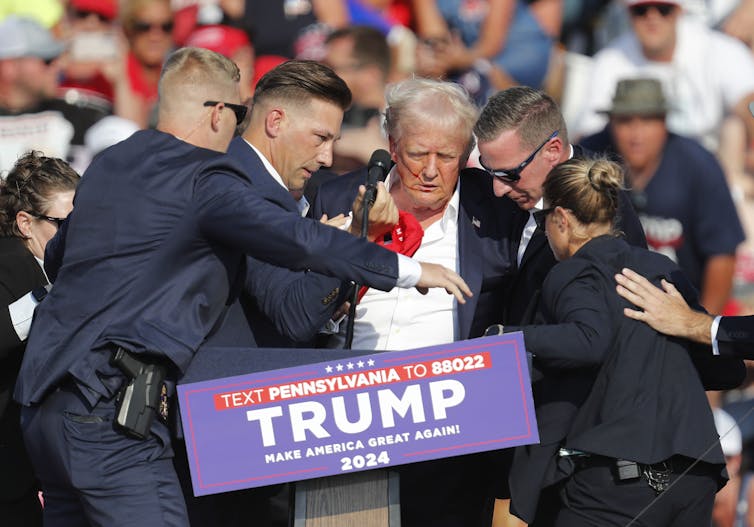
You can already see elements on the right – particularly among Trump’s supporters – attempting to use the assassination attempt to foster conspiracy theories as a rallying point for the former president.
Given the fall-out from Biden’s debate performance in recent weeks, a contrasting image of the two candidates is also emerging and could solidify further – even if it doesn’t reflect them accurately.
That image of Trump, bloodied with a raised fist, could certainly come to frame his entire campaign and rally support behind him.
It is entirely possible, then, that this becomes the moment when Trump won the election.
Republican presidential candidate former President Donald Trump and Republican vice presidential candidate Sen. JD Vance, R-Ohio, attend the first day of the Republican National Convention, Monday, July 15, 2024, in Milwaukee. (AP Photo/Evan Vucci)
Video camera operators rehearse their shots in the Fiserv Forum ahead of the 2024 Republican National Convention, Friday, July 12, 2024, in Milwaukee. (AP Photo/Alex Brandon)
President Joe Biden walks from Air Force One as he arrives at Harry Reid International Airport in Las Vegas, Monday, July 15, 2024. (AP Photo/Susan Walsh)
BY DAVID BAUDER
July 15, 2024
If this were a typical presidential campaign, Donald Trump’s selection of J.D. Vance as his running mate on the Republican ticket would have likely dominated media discussions for a week or two.
This is not a typical presidential campaign.
On Monday, that choice was just part of the mix. On the opening day of the Republican convention two days after an assassination attempt on Trump, news organizations juggled several major stories and grappled with the uncertainty of whether political violence would change the tone of their coverage.
Would a lowering of volume on political combat that some, including President Joe Biden, had called for in the wake of Saturday’s shooting be evident at news outlets that many say live for the fight?
Digging into seismic events, hoping for some wisdom
Coming from a man known for his understanding of political theater, Trump’s rollout of his Vance selection on Monday afternoon was understated. First, news organizations were fed word that two men thought to be on his short list — Florida Sen. Marco Rubio and North Dakota Gov. Doug Burgum — had been told they had not been chosen.
Shortly thereafter, Trump announced the choice of the Ohio senator in a post on his Truth Social outlet. Vance was later seen on the floor of the GOP convention in Milwaukee, accepting handshakes and hugs of congratulation.

JD Vance is a relative political unknown. He's been asked to help Donald Trump avenge his loss
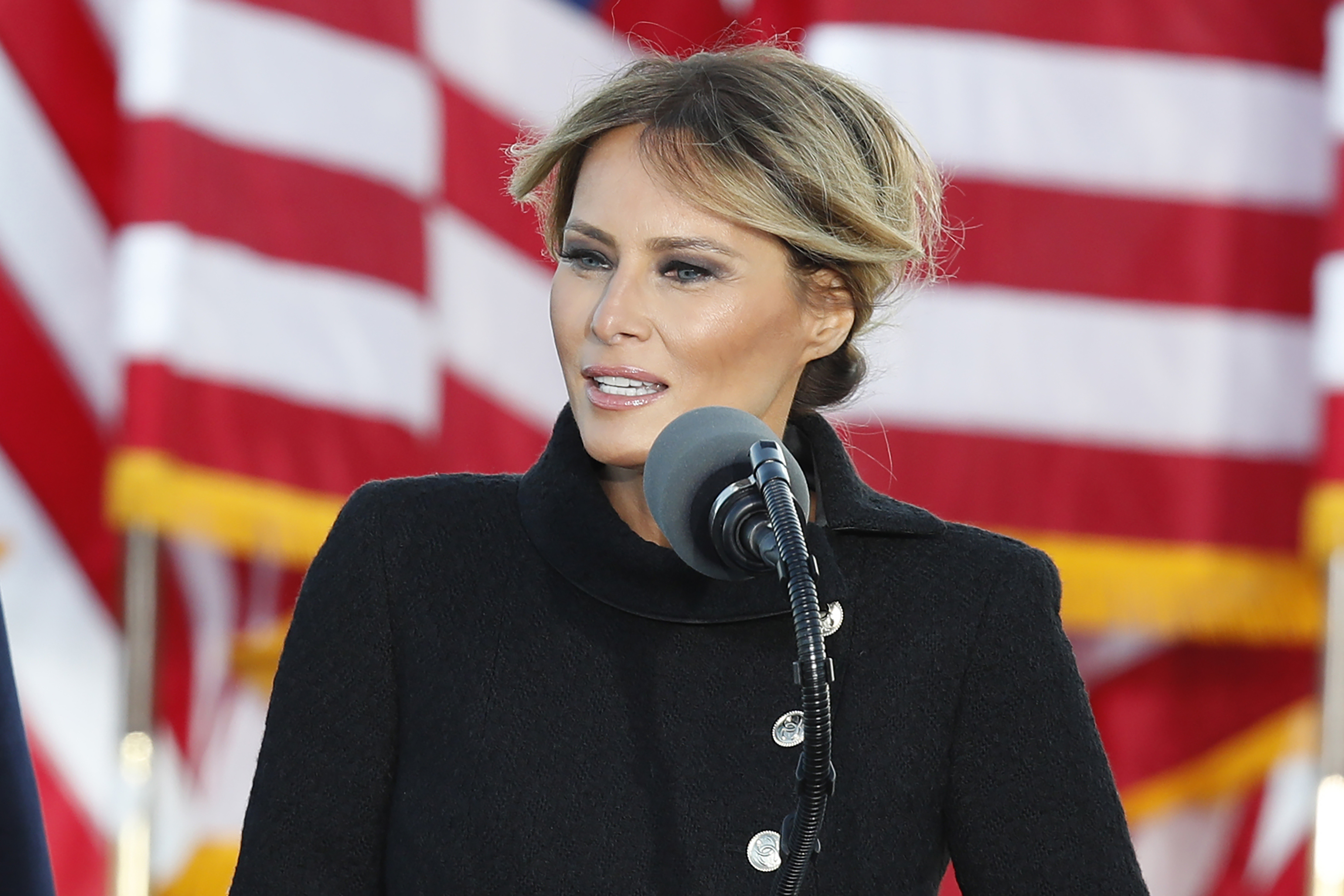
This year's RNC speakers include VP hopefuls, GOP lawmakers and UFC's CEO — but not Melania Trump
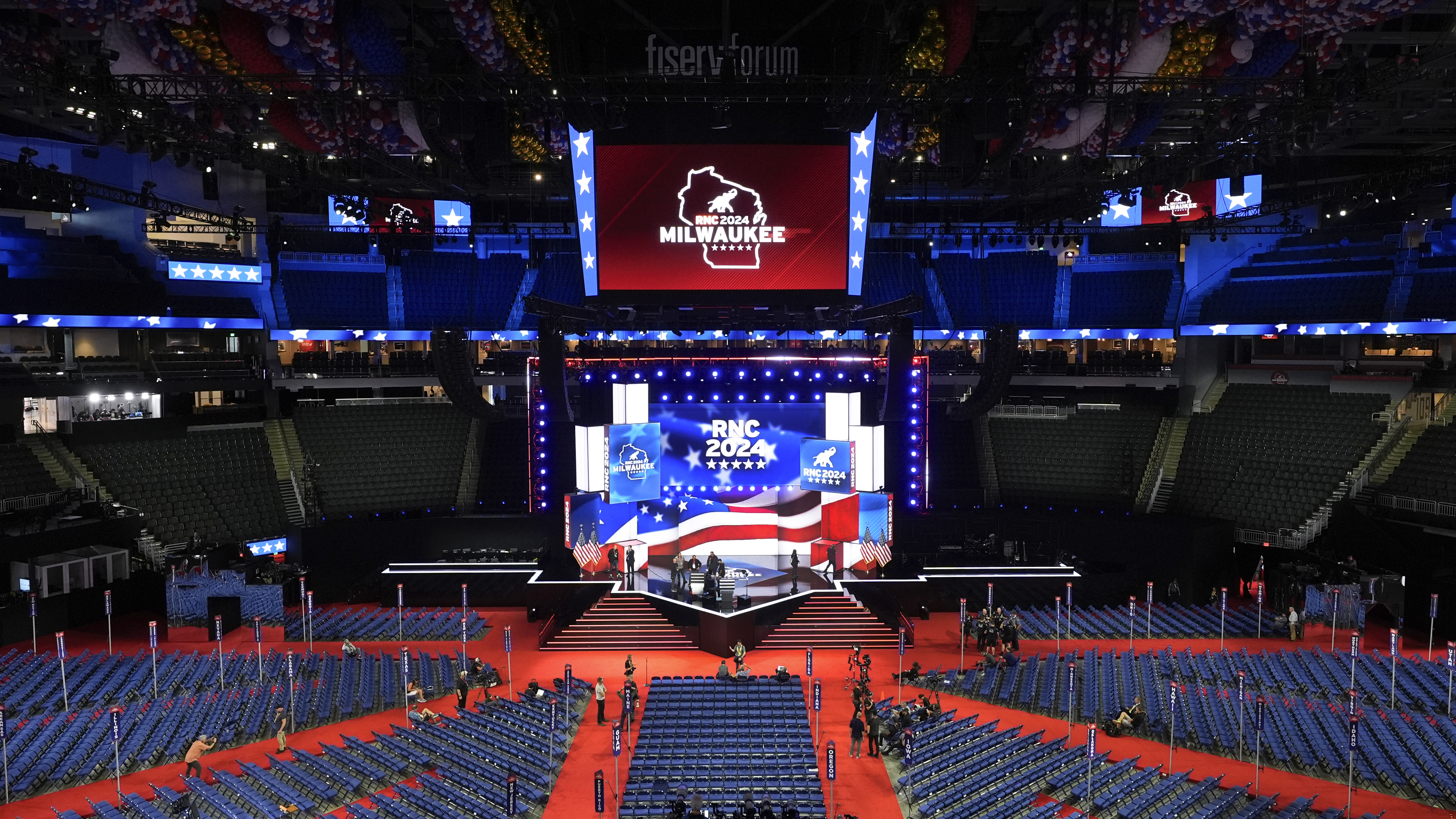
What to watch as the Republican National Convention kicks off days after Trump assassination attempt
As she spoke with politicians at the convention, CNN’s Kaitlan Collins put the question to a handful of interview subjects: How would the assassination attempt change the tone of the Republican gathering?
What to know about the 2024 Election
Democracy: American democracy has overcome big stress tests since 2020. More challenges lie ahead in 2024.
AP’s Role: The Associated Press is the most trusted source of information on election night, with a history of accuracy dating to 1848. Learn more.
We want to hear from you: Did the attempted assassination on former president Donald Trump change your perspective on politics in America?
Read the latest: Follow AP’s live coverage of this year’s election.
There was an obvious sadness, U.S. Sen. Katie Britt answered. But the conversation then turned to an accusation against the media.
“I really wish the media would do a better job of covering it when we do work together,” Britt said.
There was a bitter exchange earlier between the former president’s son, Donald Trump Jr., and MSNBC reporter Jacob Soboroff on the convention floor when the reporter asked for specifics about what Trump’s father would do on the immigrant issue.
“I expect nothing less from you clowns even today,” Trump said. “Even 48 hours later, you couldn’t wait. You couldn’t wait with your lies and with your nonsense. So just get out of here.”
Unusual day for MSNBC
It was an eventful, and odd, day for MSNBC. The network had pre-empted its opinion programming on Sunday for an NBC News Now straight news simulcast of news surrounding the assassination attempt.
But it was noticed Monday when MSNBC did not air its “Morning Joe” program, which is often filled with anti-Trump commentary from the husband-and-wife team of Joe Scarborough and Mika Brzezinski, and their colleagues. The network denied a CNN report that executives were concerned that someone on the show might make an inappropriate remark, and said “Morning Joe” would be back on Tuesday.
It didn’t take long for MSNBC’s opinionated programming to make its return on Monday.
The network opened its convention coverage with Rachel Maddow reciting a lengthy list of unflattering things Vance had said about Trump during the former president’s early years in politics. The network’s five-woman anchor team — Maddow, Joy Reid, Jen Psaki, Nicolle Wallace and Alex Wagner — assailed Vance’s views on abortion.
“The pick of J.D. Vance is saying to women, go to hell,” Reid said.
Biden makes an appearance
Over on Fox News Channel, Brit Hume predicted Vance would “run rings” around Vice President Kamala Harris in a debate. Jessica Tarlov and Greg Gutfeld battled over which party was more guilty of inflammatory rhetoric.
Both NBC and MSNBC set aside programming for 20 minutes at 9 p.m. Eastern to air an interview Lester Holt conducted with President Biden earlier in the day — one where the anchor was forced to revamp his list of questions since it was arranged last week.
Holt asked Biden about his phone call to Trump after the shooting and confronted the president about whether a statement he had made last week was too provocative. Biden had told donors that after the presidential debate, “it’s time to put Trump in a bullseye” and said Monday that was a mistake. Holt asked about Vance’s choice and a judge’s decision Monday to throw out a case against Trump for taking classified documents.
Questions about whether or not Biden would stay in the race following a poor performance in the debate against Trump — which thoroughly dominated last week’s news cycle — didn’t come up until past the halfway point in the interview.
Even then, the president flashed annoyance, suggesting the spotlight should instead be on Trump for things the Republican said in the debate that were untrue. He disputed Holt’s statement that Trump had been called out for false comments.
“Sometime come and talk to me about what we should be talking about — the issues,” Biden told Holt.
___
David Bauder writes about media for the AP. Follow him at http://twitter.com/dbauder.

DAVID BAUDER
National media and entertainment writer
Within minutes of the gunfire, the attempted assassination of former President Donald Trump spawned a vast sea of claims reflecting the frightening uncertainties of the moment as well as America’s fevered, polarized political climate.
July 15, 2024
CLAIM: A law enforcement sniper assigned to former President Donald Trump’s rally Saturday in Butler, Penn., says the head of the Secret Service ordered him not to shoot the suspect accused of attempting to assassinate Trump.
AP’S ASSESSMENT: False. Snipers killed the suspected shooter moments after he opened fire on the former president, bloodying Trump’s ear, killing one rally attendee and injuring two. The Secret Service and the Butler Police Department say they have no agents, officers or employees with the name of the person claiming to be the sharpshooter.
THE FACTS: Following Saturday’s attempt on Trump’s life, a poster on the online message board 4chan wrote that they were a sniper assigned to the rally, and that they can be seen in a photo of two law enforcement officers on the roof at the rally.
“My name is Jonathan Willis,” the poster wrote. “I came here to inform the public that I had the assassin in my sights for at least 3 minutes, but the head of the secret service refused to give the order to take out the perp. 100% the top brass prevented me from killing the assassin before he took the shots at president Trump,” the post claimed.
But there is no agent or officer by the name of Jonathan Willis working for the Secret Service or the Butler police, and no internet records of such an officer could be located.
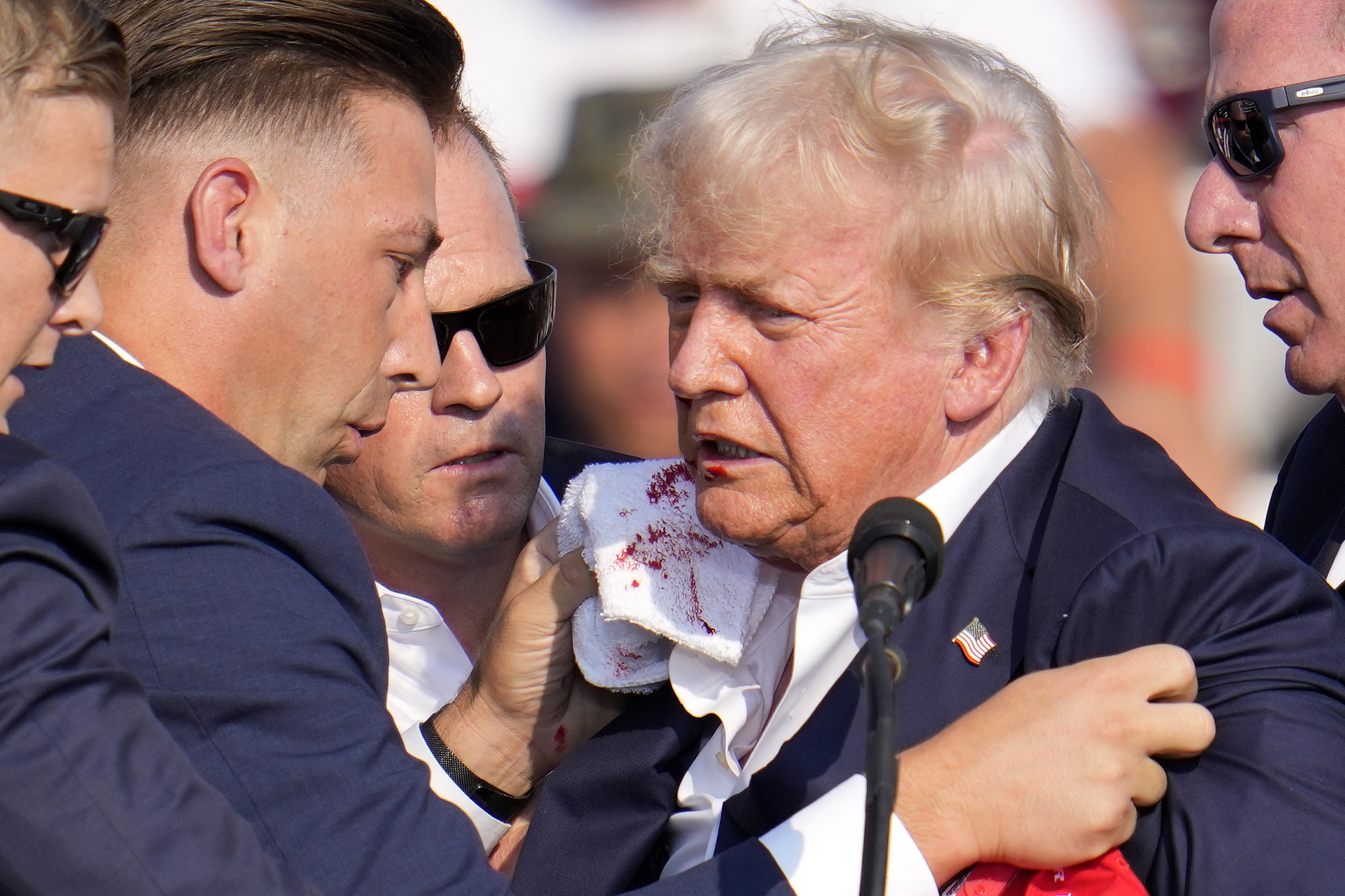
A look at false claims around the assassination attempt on Trump
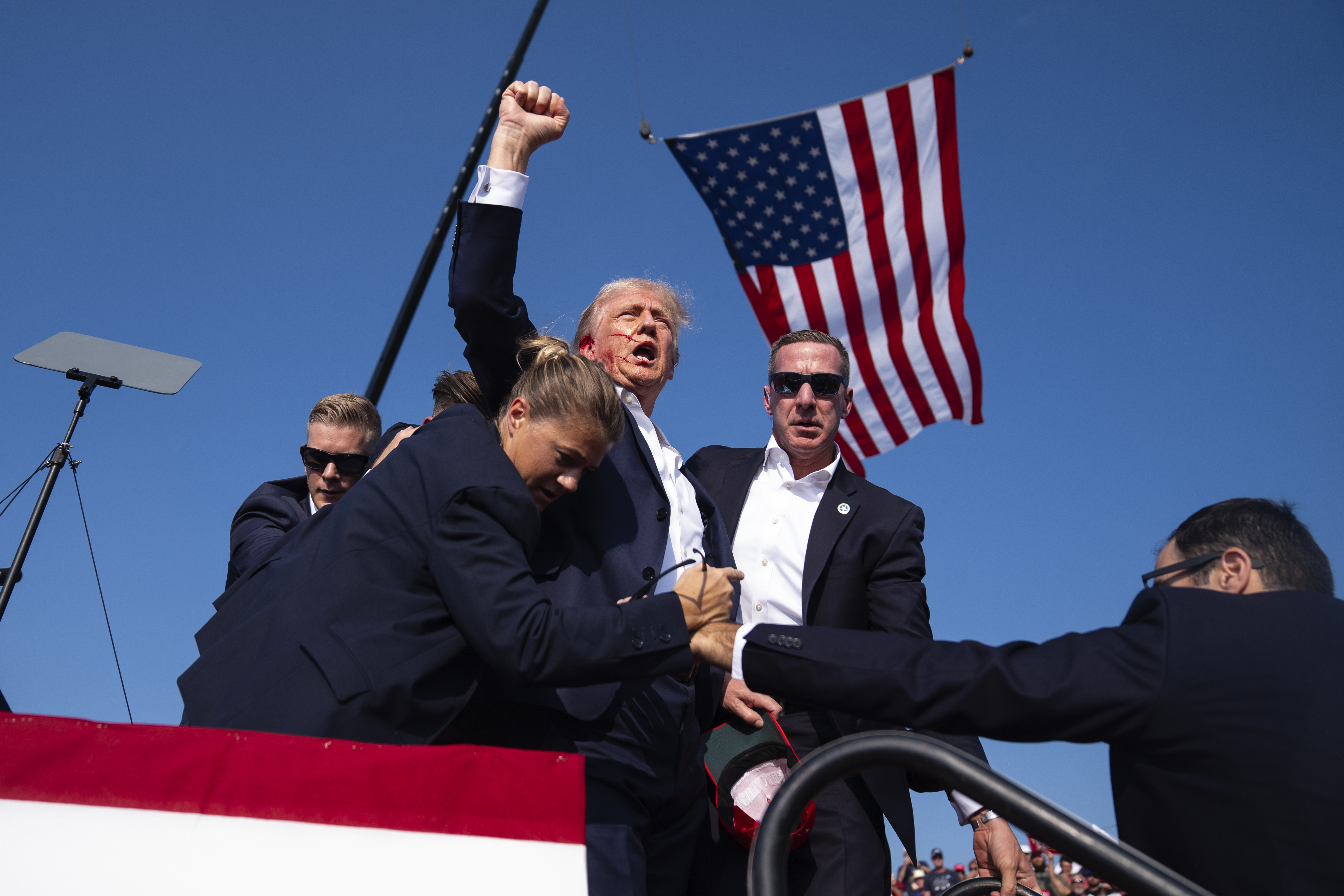
Photo edited to make it appear Secret Service agents were smiling after attempt on Trump’s life
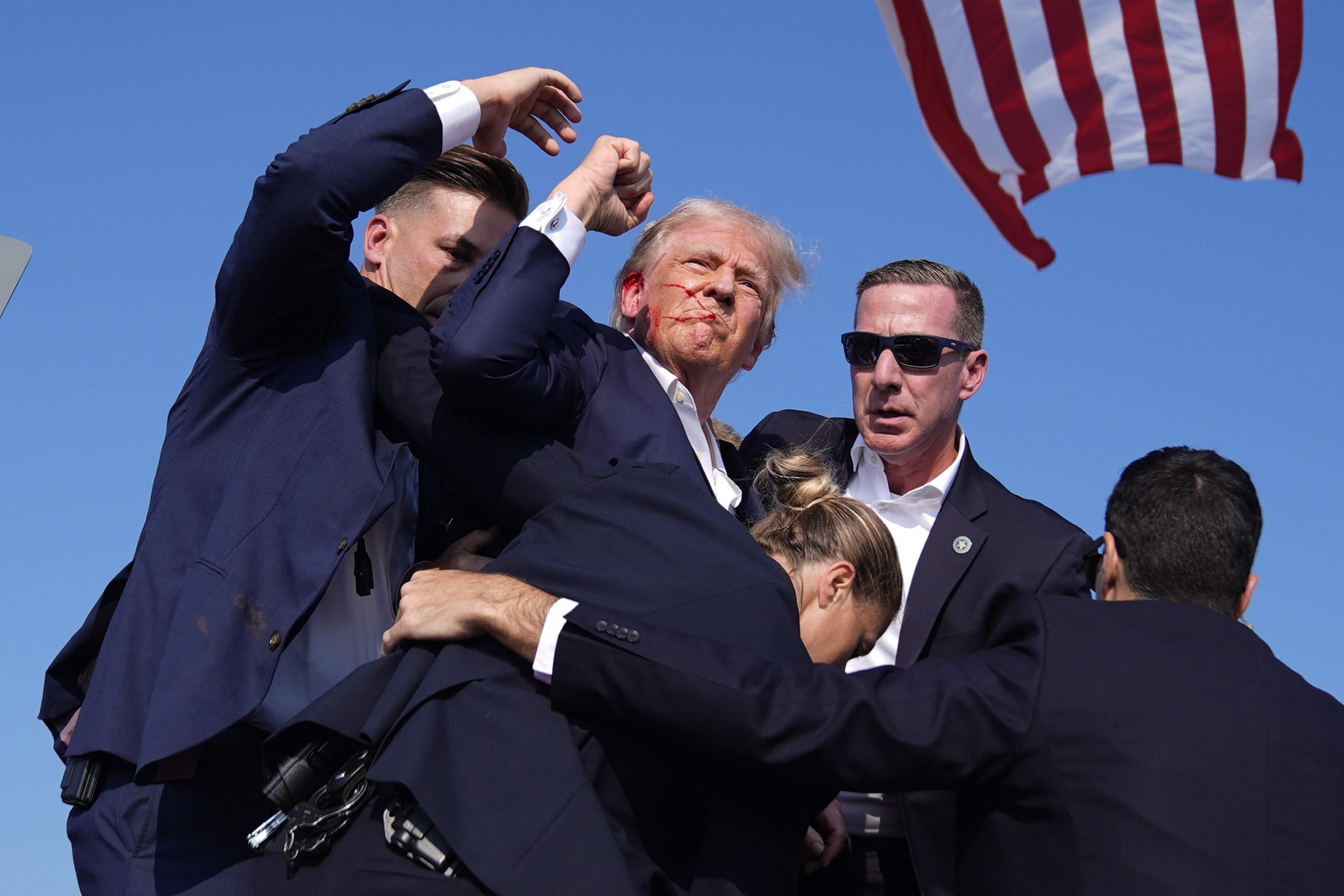
Posts misrepresent photo to claim Trump was shot in the chest and saved by a bulletproof vest
A spokesman for the Secret Service said snipers are trained and instructed to act whenever they see a threat, and do not await instructions before taking a shot to neutralize a suspect. He said he couldn’t discuss the specifics of agency communication or the details of the ongoing investigation but said the post was false.
Witnesses at the rally alerted law enforcement to the suspect, identified as Thomas Matthew Crooks, after they saw him perched atop a nearby roof. A local law enforcement officer climbed to the roof and found Crooks, who pointed the rifle at the officer. The officer retreated down the ladder, and the gunman quickly fired toward Trump, the officials said. That’s when U.S. Secret Service gunmen shot him, officials have said.
___
This is part of the AP’s effort to address widely shared false and misleading information that is circulating online. Learn more about fact-checking at AP.
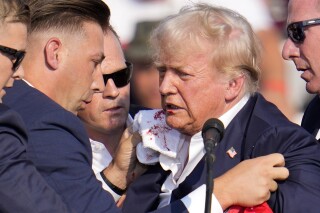
Republican presidential candidate former President Donald Trump is surrounded by U.S. Secret Service at a campaign event in Butler, Pa., on Saturday, July 13, 2024. (AP Photo/Gene J. Puskar)
BY MELISSA GOLDIN AND DAVID KLEPPER
July 15, 2024
The assassination attempt on former President Donald Trump, who is running for reelection, is fueling a range of false claims and conspiracy theories as authorities seek information about the 20-year-old shooter’s background and motive, how he obtained the AR-style rifle he fired at Trump and security at the venue that failed to stop the shooting.
Here’s a look at the facts.
___
Online posts falsely claim sharpshooter was told not to fire on suspect in Trump shooting
CLAIM: A law enforcement sniper assigned to Trump’s rally Saturday in Butler, Pennsylvania, says the head of the Secret Service ordered him not to shoot the suspect accused of attempting to assassinate Trump.
THE FACTS: No such order was made. Snipers killed the suspected shooter moments after he opened fire on the former president, bloodying Trump’s ear, killing one rally attendee and injuring two. The Secret Service and the Butler Police Department say they have no agents, officers or employees with the name of the person claiming to be the sharpshooter.
Following Saturday’s attempt on Trump’s life, a poster on the online message board 4chan wrote that they were a sniper assigned to the rally, and that they can be seen in a photo of two law enforcement officers on the roof at the rally.
“My name is Jonathan Willis,” the poster wrote. “I came here to inform the public that I had the assassin in my sights for at least 3 minutes, but the head of the secret service refused to give the order to take out the perp. 100% the top brass prevented me from killing the assassin before he took the shots at president Trump,” the post claimed.
But there is no agent or officer by the name of Jonathan Willis working for the Secret Service or the Butler police, and no internet records of such an officer could be located.
A spokesman for the Secret Service said snipers are trained and instructed to act whenever they see a threat, and do not await instructions before taking a shot to neutralize a suspect. He said he couldn’t discuss the specifics of agency communication or the details of the ongoing investigation, but said the post was false.
Witnesses at the rally alerted law enforcement to the suspect, identified as Thomas Matthew Crooks, after they saw him perched atop a nearby roof. A local law enforcement officer climbed to the roof and found Crooks, who pointed the rifle at the officer. The officer retreated down the ladder, and the gunman quickly fired toward Trump, the officials said. That’s when U.S. Secret Service gunmen shot him, officials have said.
Crooks, a nursing-home employee from suburban Pittsburgh, fired multiple shots at Trump with an AR-style rifle. A spectator was killed and two others were critically injured.
Authorities said the shooting was an attempted assassination, but haven’t yet determined what motivated Crooks to try to kill Trump, the AP has reported.
___
Posts misrepresent photo to claim Trump was shot in the chest and saved by a bulletproof vest
CLAIM: A photo shows a bullet hole in Trump’s suit jacket, proving that he was shot in the chest during the attempted assassination.
THE FACTS: The photo actually shows a fold in the suit jacket of a Secret Service agent protecting Trump. Another Associated Press image taken moments before clearly shows there is no hole in Trump’s jacket. What appears to be a hole can be seen diminishing as the agent moves in video of the shooting’s aftermath.
Social media users are sharing the photo from the assassination attempt to claim that the former president was shot in the chest. Some posts suggest he survived because he was wearing a bulletproof vest.
In the image, what seems to be a small hole appears inches below Trump’s right underarm. Many posts use a zoomed-in version of the photo that has a circle around the supposed hole to emphasize the hard-to-notice detail.
“#Trump was also shot in the chest,” reads one X post. “The bulletproof vest saved him #We support Trump.
Another X post similarly reads, “It appears that Trump was shot in the chest, as the bullet seem to have pierced his suit; he was wearing a bulletproof vest.”
But the apparent hole is actually a fold in the sleeve of the Secret Service agent’s jacket, not the aftermath of a bullet.
The photo taken by an AP photographer shows the agent bending over as she protects Trump, her jacket appearing slightly darker than the former president’s. The fold can be seen by following the edge of the agent’s jacket from her neck to just below her left shoulder.
Moreover, another AP image taken moments before the one with the supposed hole clearly shows the right side of Trump’s jacket as he raises his fist. No hole can be seen in the jacket.
Trump wrote on his social media platform that he was “shot with a bullet that pierced the upper part of my right ear.” Photos and video from the rally show blood on his right ear and on the right side of his face.
The Secret Service declined to comment on details of the shooting, including where the bullets hit, and did not respond to a follow-up inquiry about whether Trump was wearing a bulletproof vest. Trump’s campaign did not respond to a request for comment.
___ Photo edited to make it appear Secret Service agents were smiling after attempt on Trump’s life
CLAIM: A photo from the attempted assassination of Trump shows Secret Service agents smiling as they surround him after the shooting.
THE FACTS: The photo was edited to make it appear the agents were smiling. In the original, taken by an Associated Press photographer, the same agents can be seen with neutral expressions.
After the shooting, social media users shared the altered image, with some suggesting it was evidence that the assassination attempt had been staged.
The photo shows Trump with blood on his face and ear, pumping his fist in front of an American flag while Secret Service agents surround him. Three agents whose faces are visible seem to be grinning as they protect the former president.
“Why are all 3 Secret Service agents smiling, at least that is how it appears to me,” reads one post on X. “Do to the seriousness of the situation, I would think their expressions would be grim + determined. Now, if it was a staged event, these expressions would make more sense.”
But the agents were not smiling at that moment. The photo was edited to make it appear otherwise.
The original image shows the same three agents with neutral expressions. One man is positioned behind Trump, a second man stands by his left shoulder and a woman is bent over on his right side, beneath his raised arm.
___
Find AP Fact Checks here: https://apnews.com/APFactCheck.
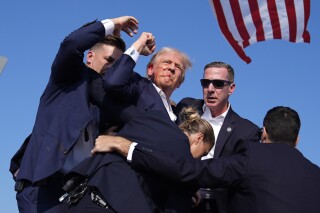
Republican presidential candidate former President Donald Trump is surround by U.S. Secret Service agents at a campaign rally, Saturday, July 13, 2024, in Butler, Pa. Social media users are misrepresenting this photo to claim that Trump was shot in the chest and save by a bulletproof vest. (AP Photo/Evan Vucci)
BY MELISSA GOLDIN
July 15, 2024Share
CLAIM: A photo shows a bullet hole in former President Donald Trump’s suit jacket, proving that he was shot in the chest during an attempted assassination on Saturday.
AP’S ASSESSMENT: False. The photo actually shows a fold in the suit jacket of a Secret Service agent protecting Trump. Another Associated Press image taken moments before clearly shows that there is no hole in Trump’s jacket. What appears to be a hole can be seen diminishing as the agent moves in video of the shooting’s aftermath.
THE FACTS: Social media users are sharing the photo from the assassination attempt at Trump’s rally in Butler, Pennsylvania, to claim that the former president was shot in the chest. Some posts suggest he survived because he was wearing a bulletproof vest.
In the image, what seems to be a small hole appears inches below Trump’s right underarm. Many posts use a zoomed in version of the photo that has a circle around the supposed hole to emphasize the hard-to-notice detail.
“#Trump was also shot in the chest,” reads one X post. “The bulletproof vest saved him #We support Trump.
Another X post similarly reads: “It appears that Trump was shot in the chest, as the bullet seem to have pierced his suit; he was wearing a bulletproof vest.”
RELATED STORIES

Photo edited to make it appear Secret Service agents were smiling after attempt on Trump’s life

A look at false claims around the assassination attempt on Trump
But the apparent hole is actually a fold in the sleeve of a Secret Service agent’s jacket, not the aftermath of a bullet.
The photo, taken by an AP photographer, shows the agent bending over as she protects Trump, her jacket appearing slightly darker than the former president’s. The fold can be seen by following the edge of the agent’s jacket from her neck to just below her left shoulder. It is also visible in video of the shooting’s aftermath, where it can be seen diminishing as the agent moves.
Moreover, another AP image taken moments before the one with the supposed hole clearly shows the right side of Trump’s jacket as he raises his fist. No hole can be seen in the jacket.
Trump wrote on his social media platform that he was “shot with a bullet that pierced the upper part of my right ear.” Photos and video of the assassination attempt show blood on his right ear and on the right side of his face.
The Secret Service declined to comment on details of the shooting, including where the bullets hit, and did not respond to a follow-up inquiry about whether Trump was wearing a bulletproof vest. Trump’s campaign did not respond to a request for comment.
Thomas Matthew Crooks, a 20-year-old nursing-home employee from suburban Pittsburgh, fired multiple shots at Trump with an AR-style rifle from a nearby roof at a rally for the Republican nominee on Saturday. He was killed by Secret Service personnel, officials said. A spectator was killed and two others were critically injured.
Authorities said the shooting was an attempted assassination, but haven’t yet determined what motivated Crooks to try to kill Trump, the AP has reported.
___
This is part of the AP’s effort to address widely shared false and misleading information that is circulating online. Learn more about fact-checking at AP.
Photo edited to make it appear Secret Service agents were smiling after attempt on Trump’s life
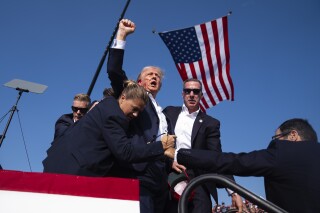
Republican presidential candidate former President Donald Trump is surrounded by U.S. Secret Service agents at a campaign rally, Saturday, July 13, 2024, in Butler, Pa. Social media users are sharing an edited version of this photo that makes it appear the agents were smiling. (AP Photo/Evan Vucci)
BY MELISSA GOLDIN
CLAIM: A photo from the attempted assassination of former President Donald Trump on Saturday shows Secret Service agents smiling as they surround him after the shooting.
AP’S ASSESSMENT: False. The photo was edited to make it seem as though the agents were smiling. In the original, taken by an Associated Press photographer, the same agents can be seen with neutral expressions.
THE FACTS: After the shooting at Trump’s rally in Butler, Pennsylvania, social media users shared the altered image, with some suggesting that it was evidence that the assassination attempt had been staged.
The photo shows Trump with blood on his face and ear, pumping his fist in front of an American flag while Secret Service agents surround him. Three agents whose faces are visible seem to be grinning as they protect the former president.
“Why are all 3 Secret Service agents smiling, at least that is how it appears to me,” reads one post on X. “Do to the seriousness of the situation, I would think their expressions would be grim + determined. Now, if it was a staged event, these expressions would make more sense.”
But the agents were not smiling at that moment. The photo was edited to make it appear otherwise.
The original image, which was taken by an AP photographer, shows the same three agents with neutral expressions. One man is positioned behind Trump, a second man stands by his left shoulder and a woman is bent over on his right side, beneath his raised arm.
Thomas Matthew Crooks, a 20-year-old nursing-home employee from suburban Pittsburgh, fired multiple shots at Trump with an AR-style rifle from a nearby roof at a rally for the presumptive Republican nominee on Saturday. He was killed by Secret Service personnel, officials said. Trump was bloodied and wrote on his social media platform that he was “shot with a bullet that pierced the upper part of my right ear.” A spectator was killed and two others were critically injured.
Authorities said the shooting was an attempted assassination, but haven’t yet determined what motivated Crooks to try to kill Trump, the AP has reported.
___
This is part of the AP’s effort to address widely shared false and misleading information that is circulating online. Learn more about fact-checking at AP.
MELISSA GOLDIN
Goldin debunks, analyzes and tracks misinformation for The Associated Press. She is based in New York.


